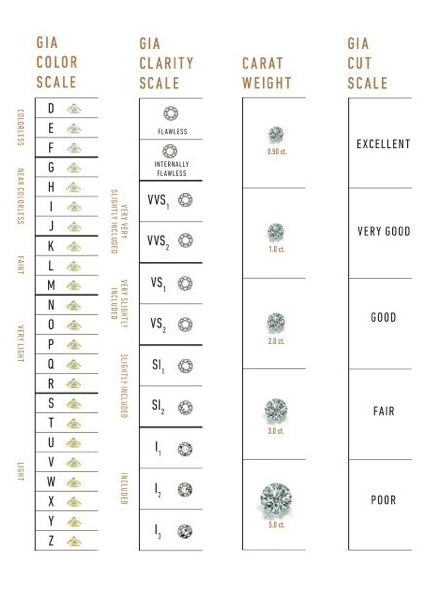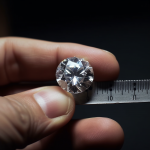Diamond Prices
Read more
GIA: the World’s Nº1 Leading Authority in Diamond Grading
The Gemological Institute of America, GIA, diamond testing laboratory; a third-party review.
In the diamond trade, nothing is left to chance. Hundreds of third-party laboratories issue diamond certificates that guarantee the specific qualities of any stone.
However, not all certificates are made equal. Those that come from more reputable laboratories can have a positive effect on a diamond’s price. Others come from more questionable sources and are looked upon with distrust.
In this article, we will be looking into one of the most famous laboratories in the world – the Gemological Institute of America. Many consider the GIA to be the golden standard for testing diamonds. Continue reading to learn more about one of the pioneers of diamond grading standardization.
The History of the GIA
The Gemological Institute of America was established in 1931 in Carlsbad, California. Its founder, Robert M. Shipley was a former jeweler. Although he was an expert jeweler and an owner of several stores, two of his best customers revealed he had a lack of expertise.
Much humbled by this encounter and having lost all of his business due to a divorce, he set out to reinvent himself as a teacher and a gemology expert. He traveled to England and completed a correspondence course in gemology by the Great Britain National Association of Goldsmiths.
In 1929 Shipley returned to the U.S. and launched a preliminary course in gemology. He traveled all over the country to promote the standardization and professionalization of the jewelry industry in the U.S. through education.
At the time the jewelry trade in the US was plagued by decentralization and a lack of unified standards. The levels of trust within the industry were notoriously low. Thus, Shipley saw it as his mission to restore the confidence of the public.
His fundamental vision was that all gemologists should have specialized education and have standardized criteria for buying and selling gemstones.
Ever since its establishment in 1931, the insitute has been instrumental in standardizing the knowledge and equipment within the American jewelry trade. In 1934 they patented a loupe with a triple aplanatic lens. This became the standard professional jeweler’s loupe. In 1937 the GIA patented the first gemological microscope. This allowed gemologists to examine the interior of gems.
In 1940 Richard Liddicoat joined the team. He would later become known as the ‘father of modern gemology’. In 1947 he issued the first edition of his Gem Identification Handbook. At the same time, Liddicoat developed grading criteria for diamonds that eventually became known as the “4Cs”. In 1953, the GIA issued its first diamond grading report Liddicoat’s criteria became an international standard.
In 1960, the insitute published a Diamond Dictionary, the first international industry reference for diamond terminology. In the following decades, the GIA became accredited as a financial institution and branched out in different countries, including Japan, India, Korea, and Europe.
In 2005 the GIA introduced a cut grade for round brilliant diamonds with D-to-Z colors. In 2007 they created the refined International Diamond Grading System™ based on the 4Cs. In the 2010s the GIA opened laboratories in Tokyo, Ramat Gan, Surat, Antwerp, Mumbai, Johannesburg, and Gaborone.
What are the GIA grading rules?

The GIA still uses the grading system that Liddicoat developed in the 1940s. Although they did introduce a cut grade and remodified the system slightly in 2007. Their grading rules are based on the four fundamental C’s – carat, color, clarity, and cut.
Their labs use precisely balanced scales to measure the carat weight of each gemstone. The larger the gemstone, the rarer and more expensive it is. Just a reminder that one carat equals 0.2 grams. The minimum diamond weight you can submit for grading with the GIA is 0.15 ct.
The color qualities of a diamond are graded according to the GIA color scale. It goes from D (colorless) to Z (light tint). Diamonds from D to F are considered colorless. From G to J they are nearly colorless. From K to M they have a slight tint. From N to R they have a very light tint. From S to Z they are classified as having a light tint.
The GIA classifies the clarity of diamonds into five big categories – flawless, very very slightly included, very slightly included, slightly included, and included. Each of these categories has a subcategory, based on the size, location, number, and brightness of the internal inclusions. In total the whole scale is the following: Flawless, Internally Flawless, VVS1 & VVS2, VS1 & VS2, SI1 & SI2, and I1 & I2 & I3.
Lastly, they examine the quality of a diamond’s cut. There are five cut grades on the GIA scale – Excellent, Very Good, Good, Fair, and Poor. These grades are a combination of the diamond’s face-up appearance, design, and craftsmanship. More measurably, the brightness, scintillation, weight ratio, durability, polish, and symmetry. The GIA has specific guidelines for each variable.
What does the GIA grading report include?

The GIA offers a variety of grading reports based on your needs. However, reports only apply to loose, natural, D-to-Z colored diamonds, with a minimum weight of 0.15 carats. Standard round brilliant cut diamonds also receive a cut grade.
The basic report covers all the fundamental characteristics of your diamond. You can top this up with a diamond origin report, that examines the chemical structure of the diamond and traces it back to its country of origin. GIA also offers a diamond dossier, which includes the two previous services and adds a laser inscription on the diamond of the report number.
Lastly, the GIA offers an e-report, that features all the previous services, but it is issued online and kept in the secure GIA database. The report includes a high-resolution image, that allows for significant magnification to see inclusions.
A typical GIA report has the logo at the top left corner and begins with a report number. You can use this number to verify the report online. The first section of the report states the date and the report number, the shape, the cutting style, and the precise measurements of your diamond in millimeters.
The next section concerns the grading results. The weight of the diamond is reported in carats up to the second decimal. The color grade is expressed in a letter from D to Z. The clarity grade is reported according to the GIA scale. If the diamond is a round cut brilliant, a cut grade is also reported here.
The following section gives additional grading information. It concerns the grades of the polish and symmetry and also reports if any fluorescence has been detected. Any inscriptions on the diamond are also reported. If you opted for the origin report, the country of origin will be stated.
Afterward, there is a sketch of the diamond in profile, with all of its proportions reported in detail. The quality of these proportions forms one of the foundations for the cut grade. There is another sketch of the diamond seen from the top. This sketch shows the clarity characteristics and shows the location and type of inclusions.
In the last section of the report, the GIA scales for color, clarity, and cut are included for ease of reference for the customer. Further comments may also be included, if any treatments have been found on the diamond, or if it has any outstanding quality.
The GIA Competitive Advantage
The GIA name has become synonymous with quality and reliability in the gemstone industry. Their reputation is the biggest asset for your diamond. No one doubts GIA reports and they have become the default option for most jewelers. You might take the 4C’s for granted, but it was due to the efforts of the GIA that we have standardized systems and vocabulary to communicate the qualities of diamonds effectively.
The GIA’s reputation is owed due to the expertise and experience of the staff, the quality of their equipment, their dedication to being at the forefront of academic studies in gemology, and their experience as an educational facility.
The GIA Academy and learning opportunities
The GIA is one of the world’s leaders in gemstone education. They have campuses in Carlsbad, New York, Bangkok, Hong Kong, London, Mumbai, and Taipei. The GIA also has active locations in Surat, India, and partnerships with Chinese universities. Within these campuses, you can select a variety of programs.
There are e-learning courses, lab classes, certificate programs, and a full-on gemology diploma program. Classes are specialized and practically oriented. Different diploma programs include applied jewelry, colored stones, diamonds, gemology, jewelry, pearls, and a design and technology program.
We hope you have enjoyed the read!
To sum things up, the GIA is the industry standard in both grading and education. They have had immense contributions to the world of diamonds and have significantly shaped the way we talk about diamonds today. If you’d like to learn about other reputable laboratories, you can check out our articles on Gubelin and SSEF.



